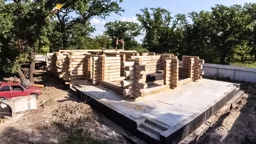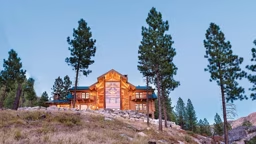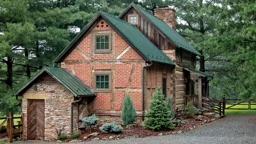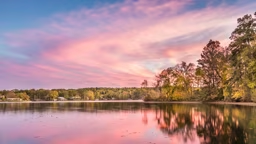Photos courtesy of Pan Abode Cedar Log Homes

It’s no wonder waterfront settings are popular spots for log homes. After all, coastal, lakefront and riverside properties provide gorgeous views, an all-access pass to water sports and activities, and a peaceful backdrop for your own getaway retreat. But there are some challenges to building on the water.
For example, many areas have stringent setbacks and building requirements you’ll have to consider and work around. You also might be building on a sloped lot or have tree lines to contend with while situating the house to achieve the best views and most functional floor plan.
Fortunately, if you work with a log home company and designer that is experienced and knowledgeable about building on waterfront properties, you should be covered.
Ready to dive in? Here’s what you need to know.
Take in the Views
A waterfront property will most likely provide spectacular views, so consider those first. When working on your initial floor plan, place rooms carefully to best take advantage of those views.Think about orienting popular living spaces like the great room, kitchen and dining area, master bedroom, and screen porch or four-season room on the side of the home that faces the water. Large expanses of glass in the form of windows or doors will allow you to enjoy your waterfront property from both the indoors and out.
Bring the Outdoors In
You and your guests will want to have easy access to the water, so entrances to and from should be conveniently located in your floor plan. Think about providing an outside door that leads directly into a bathroom or laundry/mudroom area.Including this space will make it easy for people to shower, dry off and clean up without having to walk through the house. Patio doors or fold-in window walls provide great indoor access from the main living area to the outdoor spaces.
Maximize Waterfront Living
Of course, outdoor living space is another key factor in a waterfront home. To enjoy the surrounding landscape as much as possible, think about incorporating a grilling station, outdoor kitchen, dining area, bar, fireplace, gazebo or pergola on your property.Private balconies or patios off a master suite are nice addition, and if you live in a buggy area, a screened porch or four-season room might be a good idea as well.
Don’t Skimp on Storage
Some homeowners who live on the water also might need storage space for boats, canoes, fishing poles or jet skis.Building a boat house near the water is ideal, but an additional garage or shed structure also would do the trick. On your home’s main garage, also consider adding a door on the water side of the structure to accommodate added storage needs.
Protecting Your Log Home: The Science Behind Water & Sun Damage
Protecting wood surfaces in beach or waterfront environment is a challenge. You are faced with numerous variables that contribute to erosion and degradation of the wood, including sunlight, wind, moisture, salt and sand.The two most destructive environmental variables you’ll be faced with are sunlight and water. Sunlight is the major cause of damage to a number of materials, including plastics, textile, wood and coatings. The type of damage, such as loss of gloss, chalking, elasticity, adhesion and color change varies depending on the material sensitivity and the amount of sunlight.
Ultraviolet or UV light is responsible for most damage to exposed wood because it changes or destroys the lignin, a component of wood that hardens and strengthens the cell walls. The more colorant a finish contains, the less UV light will get through, so opaque finishes like paint and solid-body stains are good choices for protecting your wood. That’s why when they peel off, the freshly exposed wood may still look bright. On the other hand, the objective of transparent stains is to allow the character of the wood to show through.
Darker stains typically contain more colorant than lighter ones, so they tend to last longer, but lighter stains that contain titanium white will also absorb less heat, which means there will be less overall stress that the finish system and wood substrate will be exposed to over the course of a 24-hour period.
The second challenging variable to consider is moisture. Coastal and waterfront areas can also bring with them high relative humidity and pop-up storms. If wood remains wet for long periods of time without drying out, conditions are favorable for the formation of wood-decay fungi, the precursor to wood rot.
A microporous finish will repel water while permitting flexibility, which will prevent blistering and cracking due to temperature and/or moisture-related contraction and expansion.
Pan Abode Cedar Homes, since 1952, has brought Custom Cedar Homes & Cedar Cabins of Post and Beam, Timber, and Log to life with innovative designs, cutting-edge engineering and Three unique Building Systems featuring Western Red Cedar & Douglas Fir.













